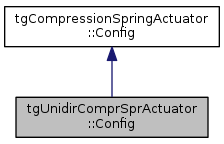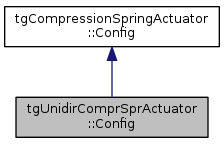|
NTRT Simulator
Version: Master
|
|
NTRT Simulator
Version: Master
|
#include <tgUnidirComprSprActuator.h>


Public Member Functions | |
| Config (bool iFEA=false, double s=1000.0, double d=10.0, double rL=0.0, bool moveCPA=true, bool moveCPB=true, btVector3 *dir=(new btVector3(0, 1, 0))) | |
Public Attributes | |
| btVector3 * | direction |
| bool | isFreeEndAttached |
| double | stiffness |
| double | damping |
| double | restLength |
| bool | moveCablePointAToEdge |
| bool | moveCablePointBToEdge |
The config struct. As of 2016-08-02, since this compression spring is unactuated, the config struct only needs a small number of the parameters in tgSpringCableActuator. Note that this is NOT re-declaring the config struct from tgCompressionSpringActuator. Instead, it is extending that struct, since structs can be inherited like classes in C++. It's extended here because of the inclusion of the 'dir' variable.
Definition at line 77 of file tgUnidirComprSprActuator.h.
| tgUnidirComprSprActuator::Config::Config | ( | bool | iFEA = false, |
| double | s = 1000.0, |
||
| double | d = 10.0, |
||
| double | rL = 0.0, |
||
| bool | moveCPA = true, |
||
| bool | moveCPB = true, |
||
| btVector3 * | dir = (new btVector3(0, 1, 0)) |
||
| ) |
Parameter defaults : Is this creating a memory leak by immediately copying the result of new btVector3 ?
Definition at line 50 of file tgUnidirComprSprActuator.cpp.
|
inherited |
Specifies the damping (b) term in the linear force equation. Units are mass / seconds Must be non-negative.
Definition at line 105 of file tgCompressionSpringActuator.h.
| btVector3* tgUnidirComprSprActuator::Config::direction |
List of the new parameters. See tgBulletCompressionSpringActuator for info about the others. All are passed in to tgBulletUnidirComprSpr. Direction vector along which the force from this spring acts. Should be checked in constructor: only allowed to be a unit vector along one of the three axes. NOTE: to have springs where the To node is in the negative direction with respect to the From node, this direction parameter should be negative.
Definition at line 109 of file tgUnidirComprSprActuator.h.
|
inherited |
List of the parameters themselves. All are passed in to tgBulletCompressionSpring. Boolean flag for attached-ness of the free end of the spring. If no, the spring only provides compression force. If yes, the spring is "attached" to both anchors, and provides a tension force too when the distance between anchors is greater than rest length.
Definition at line 90 of file tgCompressionSpringActuator.h.
|
inherited |
Control the automatic re-locating of cable anchor points.
When true, the default behavior, the specified attachment point of a cable is moved from the actual node location (for example, at the center of the circle at the end of a rod) to a location at the edge of the rigid body it's attached to (for example, on the edge of the circle at the end of a rod.)
If unsure, leave default, because when set to 'false', the cable will likely clip through the rod. Disabling automatic movement of anchor points is most useful for structures that need very particular cable placement. Here, cable attachment point "A" corresponds to the first of the two anchors of the spring-cable, or the "From" point in the tgcreator files. The "B" point corresponds to the second anchor location, or the "To" point in the tgcreator files.
These parameters are used in the createTgBulletSpringCable method inside the tgBasicActuatorInfo class.
Definition at line 135 of file tgCompressionSpringActuator.h.
|
inherited |
Rest length of the spring. At distances above this amount, no force will be applied. Must be non-negative.
Definition at line 112 of file tgCompressionSpringActuator.h.
|
inherited |
Linear Hookean stiffness of the spring (k). Must be non-negative. Upper limit depends on the timestep - stiffer springs will require a lower timestep. Units are mass / seconds^2
Definition at line 98 of file tgCompressionSpringActuator.h.